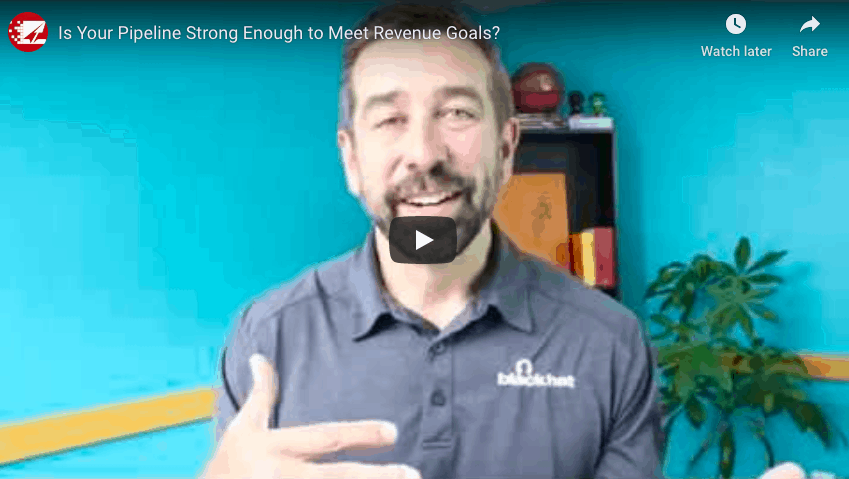Setting goals for your business is crucial for its success. Whether that’s marketing goals, personal goals, growth goals, etc.
But perhaps the most crucial for the health of your business is revenue goals. Without making consistent revenue and meeting your quota on sales, your business may not make it to the other goals you’ve set for yourself.
In this post, we’re going to help you evaluate whether your sales pipeline is strong enough to meet your revenue goals. Let’s get started!
Do the Math
To start, we’re going to do some math. This might not be everyone’s favorite subject (in fact, it’s many people’s least favorite subject), but having math and numbers to back up your revenue/sales goals is crucial in order to track success and understand the steps you need to take to follow through with goals you’ve outlined.
Mant sales teams and people will simply set some numbers like, “we want X amount of leads,” or, “X amount of deliverables/money” without doing the math to figure out whether or not their sales pipeline can support those goals. Thus, those goals are set relatively arbitrarily. This can backfire and set yourself up for failure to meet goals and meet quotas.
Without those numbers or doing that math, it’s also difficult for sales teams/people to understand the pace at which they need to work to get things done.
To avoid this, you simply have to do the math. To help, we’ve prepared a simple spreadsheet that can help you do that math to help you out. You can find the spreadsheet here. In the next section, we’re going to walk you through how the math works so that you can apply it to your own sales quota.
We’ve made some fairly large assumptions and are keeping this article very general, but you can easily take this spreadsheet and make it your own. This is simply a tool you can use to get you thinking about the math that should go into your revenue and sales goals.
Working Through the Simple Spreadsheet
Everything in the yellow boxes are the fundamental assumptions we’ve made for the purposes of this article: your yearly revenue goal, the average deal size, and your various conversion rate assumptions.
Those are the first things that you should adjust based on your sales team, your business, your product, your industry, etc, since those numbers are going to be significantly affected by those things.
Note: you may not really know these numbers right away. You need to have realistic expectations, understand the real results you get, and understand your industry. So you may need to tweak these numbers over time as you come to understand the team and the business you’re working with.
Get Aged Internet Leads
Browse, Filter, and Buy Aged Internet Leads – Instantly!
Browse, Filter, and Buy Aged Internet Leads – Instantly!
Revenue Goal
We’re going to start with a revenue goal.
For the purposes of this example, let’s say that we want to make $120,000 per year selling something. Doing a simple calculation, you can break down that yearly number into a monthly goal of $10,000 per month.
How did we get to $10,000 per month? Simply take that 120,000 yearly goal and divide it by 12.
Average Deal Size
The next important assumption is the average deal size. So, whatever you’re selling, what is the average amount that you get when the deal goes through? How much do you get paid when you make a sale?
While deals can surely vary, try and calculate the best average you can. In this example, we’re using $1,000.
Then we’re going to take that number and we’re going to divide it into the monthly revenue number you calculated earlier.
So we have $10,000 / $1,000 to get the number 10. This number is the number of things you have to sell/deals you have to make per month in order to hit your monthly goal. In this example, you need to sell 10 things every single month.
While all of this is super simple math, it’s critical for you to properly gauge and drive your sales process each month.
Sales Pipeline and Conversion Rate Assumptions
Now that you know how many sales you need to make per month, you can now start to figure out the process by which you’re going to do that. How many calls do you need to make? How do you convert leads? How do you find and generate leads to push them through your funnel? All of these things are going to affect the pace that you need to follow to reach that monthly deal number.
Here’s how we broke down the conversion rate assumptions: we took the percentage it takes to move from one stage of your funnel to the next. We know the end quota, but we need to back up to understand how many calls, meetings, contacts, etc, we need in order to end up with that quota.
Sales Qualified Lead to Closed Deals
The first one is how many sales qualified leads to turn into closed deals? That’s the first conversion rate you should calculate.
Let’s define a sales qualified lead a person that can actually purchase from you. This lead has the capacity, the need, or the want to purchase your product/service.
When you get to this stage in your sales funnel, you’re down towards the bottom of the funnel, right? When they’re a sales qualified lead, you’ve likely had multiple conversations with them, you know they’re interested, and they’ve made their way down your sales funnel, which makes them more likely to convert to a sale. You know they have the capacity, the ability, the need, etc, to buy.
All you have to do with them is to seal the deal. So from that sales qualified lead to a closing, let’s say you can generally close at a 20% rate.
To put it simply: 20% of those sales qualified leads will ultimately turn into closed deals within that month.
Get Aged Internet Leads
Browse, Filter, and Buy Aged Internet Leads – Instantly!
Browse, Filter, and Buy Aged Internet Leads – Instantly!
Lead to Sales Qualified Lead
Moving a bit farther up the funnel are leads that turn into sales qualified leads. These are leads that you’re turning into those sales qualified leads through conversations, meetings, discovering want/intent/need, etc.
These leads have some level of intent to buy, but they’re not quite at the point where they’re almost ready to close.
So what’s the definition of a lead?
A lead is simply someone that you have their name, email, phone number, etc, and they’ve shown some interest in what you’re selling. There’s some level of intent to be interested, not they’re not necessarily at the point where they have that want and need for the product/service where they’re about to buy from you. But they’ve at least shown some interest in doing business or buying what you’re selling.
These tend to convert to sales qualified leads at a pretty high rate. Around 75% of the leads that we get will turn into sales qualified leads. However, keep in mind that this number will vary greatly depending on the salesperson, the industry, the business, etc.
Contacts to Leads
In one last move up the sales funnel you get to the conversion from contacts to leads.
Let’s define a contact. A contact is a name, phone number, email, etc. Unlike a lead, these contacts haven’t necessarily shown any interest or intent in your business/product. These could be given by friends/family, referrals, networking contacts, random lists, purchasing age leads, etc.
A contact means that you have somewhere to start. This conversion rate is likely going to be the hardest to estimate since not all contacts are going to be relevant/of good quality.
Since many contacts are going to be irrelevant, out of date, bad quality, etc, we estimate a rather low conversion rate of contact to lead at about 2%.
But, let’s say it again for emphasis: all of these assumptions are going to be very different depending on your specific situation. It’s important to talk through and really understand each of these pieces so that you’ll understand the math.
Using the Numbers
We now have all of our fundamental assumptions in the spreadsheet.
Next, we’re going to take those numbers and those assumptions and figure out how many leads/contacts you need to have in each of those categories to reach your goal. This will help you understand how much you need to be doing throughout the month in order to get to where you want to be, goals-wise.
The good news is, all we have to do now is some more simple math.
We’re going to start at the top of the funnel. Take the sales quota (the number of things you need to sell), which we said was 10, and divide it by 20%. With that, you get 50 sales qualified leads.
What does that mean? It means that in order to hit your sales quota of 10, you need to produce and be working with at least 50 sales qualified leads per month.
That tells you that you need to doing enough to get 50 sales qualified leads every single month.
Now, we know what you’re thinking: “I could never get that many! How am I supposed to get that many sales qualified leads per month?”
But, remember, you don’t have to instantly have sales qualified leads. You’re also going to be working on converting leads to sales qualified leads and contacts to leads at the same time. This will push them down the funnel to the sales qualified leads you’re striving for.
Moving Down the Funnel
A funnel works by pushing large amounts down into narrower small amounts. So in order to get to your 50 sales qualified leads at the bottom of your funnel, you need to be putting in much larger numbers of leads and even larger numbers of contacts to funnel down to the 50 sales qualified leads you need.
Let’s go back to the example. You know that you need 50 sales qualified leads, so to get the number next up on the funnel (the leads), take that 50 and divide it by 75%. This tells you that in order to get those 50 sales qualified leads, you need to have ~67 leads.
You need 67 leads in order to produce 50 sales qualified leads in order to produce and close 10 sales.
Lastly, you calculate your contacts. You need to move through your contacts and find people that will become leads, then sales qualified leads, and, hopefully, then clients/customers.
Take the 67 leads you just calculated and divide it by 2%. This gives you a minimum of 3,333 contacts in order to produce the 67 leads you need to hit your quota.
That’s a huge number, but hear us out. Contacts you can get in very large numbers, but only a small amount are going to actually have an interest in your product. That’s why you need to contact so many people in order to find those few who show interest/intent.
Simple Math for Big Success
That’s basically all there is to it! While this is a simple spreadsheet that is more of a general example, you can use this process and customize it to your situations, quotas, conversion rates, sales pipeline, etc, in order to help you understand exactly what you need to get each month to be successful.
Once you have those numbers, you can better allocate your time and resources.
Hopefully, this has been helpful! If you are still feeling a bit overwhelmed, don’t hesitate to start a dialogue or ask questions in the comments. You can also contact us directly for more specific help!













